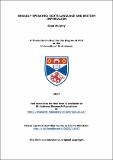Files in this item
Broadly speaking : Scots language and British imperialism.
Item metadata
| dc.contributor.advisor | Kidd, Colin | |
| dc.contributor.author | Murphy, Sean | |
| dc.coverage.spatial | [9], 241 p. | en_US |
| dc.date.accessioned | 2017-06-21T13:28:04Z | |
| dc.date.available | 2017-06-21T13:28:04Z | |
| dc.date.issued | 2017-01 | |
| dc.identifier.uri | https://hdl.handle.net/10023/11047 | |
| dc.description.abstract | This thesis offers a three-pronged perspective on the historical interconnections between Lowland Scots language(s) and British imperialism. Through analyses of the manifestation of Scots linguistic varieties outwith Scotland during the nineteenth century, alongside Scottish concerns for maintaining the socio-linguistic “propriety” and literary “standards” of “English,” this discussion argues that certain elements within Lowland language were employed in projecting a sentimental-yet celebratory conception of Scottish imperial prestige. Part I directly engages with nineteenth-century “diasporic” articulations of Lowland Scots forms, focusing on a triumphal, ceremonial vocalisation of Scottish shibboleths, termed “verbal tartanry.” Much like physical emblems of nineteenth-century Scottish iconography, it is suggested that a verbal tartanry served to accentuate Scots distinction within a broader British framework, tied to a wider imperial superiorism. Parts II and III look to the origins of this verbal tartanry. Part II turns back to mid eighteenth-century Scottish linguistic concerns, suggesting the emergence of a proto-typical verbal tartanry through earlier anxieties to ascertain “correct” English “standards,” and the parallel drive to perceive, prohibit, and prescribe Scottish linguistic usage. It is argued that later eighteenth-century Scottish philological priorities for the roots and “purity” of Lowland Scots forms – linked to “ancient” literature and “racially”-loaded origin myths – led to an encouraged “uncovering” of hallowed linguistic traits. This renegotiated reverence for certain Lowland forms was bolstered by contemporary “diasporic” imaginings – envisioning, indeed pre-empting the significance of Scots migrants in the sentimental preservation of a seemingly-threatened linguistic distinction. Part III looks beyond Scotland in the early decades of the nineteenth century. Through a consideration of the markedly different colonial and “post-colonial” contexts of British India and the early American Republic, attitudes towards certain, distinctive Lowland forms, together with Scots’ assertions of English linguistic “standards,” demonstrate a Scottish socio-cultural alignment with British imperial prestige. | en_US |
| dc.language.iso | en | en_US |
| dc.publisher | University of St Andrews | |
| dc.subject | Scotland | en_US |
| dc.subject | Language | en_US |
| dc.subject | British empire | en_US |
| dc.subject | British imperialism | en_US |
| dc.subject | Scots language | en_US |
| dc.subject | Tartanry | en_US |
| dc.subject | Empire | en_US |
| dc.subject | Imperialism | en_US |
| dc.subject | Diaspora | en_US |
| dc.subject | Dialect | en_US |
| dc.subject | Britain | en_US |
| dc.subject | History | en_US |
| dc.subject.lcc | PE2103.M8 | |
| dc.title | Broadly speaking : Scots language and British imperialism. | en_US |
| dc.type | Thesis | en_US |
| dc.contributor.sponsor | Carnegie Trust for the Universities of Scotland | en_US |
| dc.type.qualificationlevel | Doctoral | en_US |
| dc.type.qualificationname | PhD Doctor of Philosophy | en_US |
| dc.publisher.institution | The University of St Andrews | en_US |
This item appears in the following Collection(s)
Items in the St Andrews Research Repository are protected by copyright, with all rights reserved, unless otherwise indicated.

